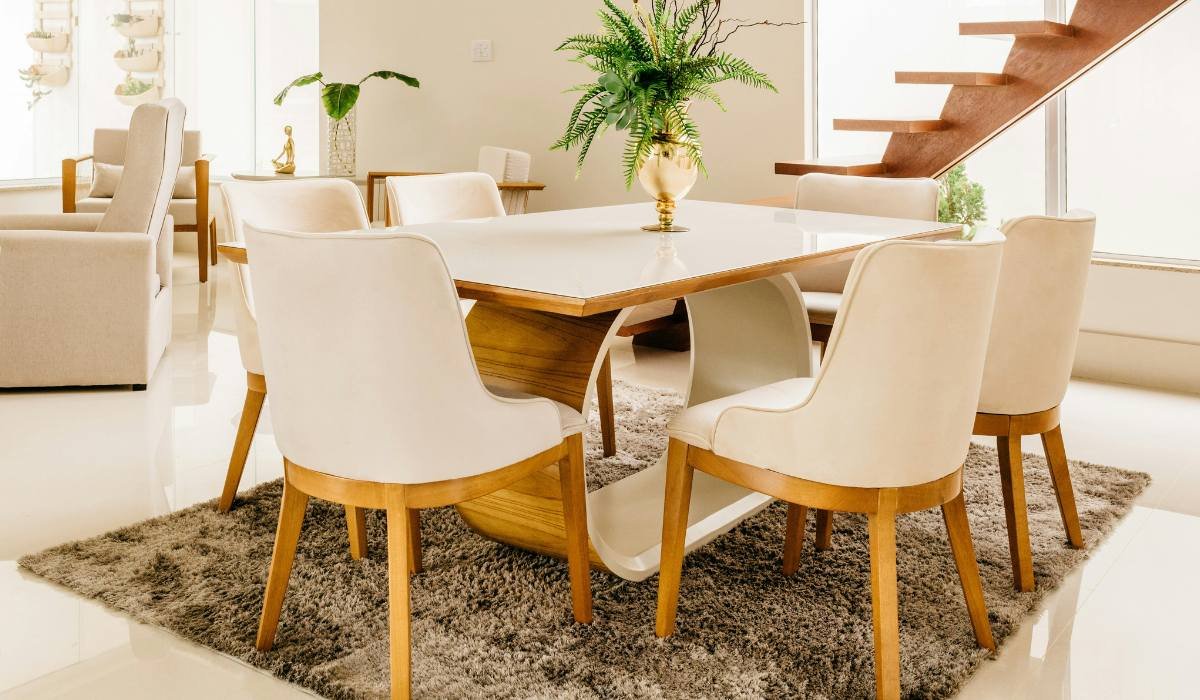Looking for a new dining table for your space? Before considering the aesthetics, it is essential to choose a type of dining table based on its functionality that fits your requirements. In this process, you need to consider various aspects of the table such as its shape, convertibility and mobility. There are plenty of options available for each of these aspects for you to choose from. Under the mobility aspect, there are largely two options available, namely fixed and rotating dining tables. This article is a guide to help you make a smart choice between these options.
See also: Modern dining table designs for contemporary homes
When to consider a fixed dining table?
Traditional dining tables are generally fixed at one spot and do not provide a lot of scope for movement. These have been used for a very long time and are preferred for their durability and ease of maintenance. You should go for this option if your priorities are the following:
Stability and durability
A fixed dining table should be your go-to choice if stability and durability are what you are looking for. This classic option provides a sturdy and secure surface for dining, especially beneficial for large families or households with children.
Space optimisation
If you prefer an enlarged space specifically dedicated to dining, fixed dining tables are ideal since they maximise the dining space. In case your dining room has limited room for movement or is not very spacious, you can get a fixed design custom-designed to fit the compact space in the most efficient way possible and ensure the best use of the available space.
Long-term investment
Fixed dining tables are constructed using high-quality materials with the aim of longevity in mind. They are built to withstand regular use and can prove to be a durable and lasting addition to the overall furniture arsenal of your home.
Customisation and design
When it comes to customisation, fixed dining tables offer a myriad of options in terms of materials, finishes and designs. Opting for a fixed table allows you vast scope to tailor it according to your preferences so that it perfectly complements your interior decor aesthetic and reflects your personality in the best possible way.
Integrated features
Several fixed dining tables are available with integrated features that add to their functionality, such as built-in storage solutions or extensions to accommodate extra seaters. A fixed table with additional smart features can meet your needs efficiently if you value functionality and convenience.
Preference for tradition
A fixed dining table can be seamlessly accommodated into an aesthetic that prioritises a traditional or classic look. This dining table is the epitome of the timeless charm of an area dedicated exclusively to function as a central gathering place for meals and socialising.
When to consider a rotating dining table?
As opposed to a fixed dining table, a rotating one provides more freedom of mobility and enhanced functionality. You should go for a rotating dining table if you value the following factors:
Space efficiency
In the case of compact dining areas and multi-functional spaces, ensure maximum space efficiency is crucial. Rotating dining tables can be an excellent choice in such situations as their compact design and 360-degree rotation feature accommodate a full-fledged dining surface without overwhelming the limited space available.
Ease of access
Compared to fixed tables, rotating tables allow greater flexibility and convenience for accessing food, dishes and condiments without reaching across the table. This is especially valued during family meals or large gatherings as it helps enhance the dining experience for everyone.
Flexible seating arrangement
Rotating dining tables provide flexibility in seating arrangements during large gatherings. Due to its mobile nature, it allows guests to access food comfortably from anywhere around the table irrespective of shape and size, without having to compromise social interaction by having to sit at a particular place.
Modern design aesthetic
Rotating tables can serve as a stylish centrepiece for your dining area if you prefer modern and innovative furniture designs. The unique rotating feature adds a contemporary charm to your space by ensuring both functionality and aesthetics and providing a convenient solution to your space optimisation woes.
Multi-purpose use
From functioning as a serving station to a display area for decorative items, the application of a rotating dining table goes beyond just dining in particular. You can even use it as a workspace in compact apartments. Versatility and adaptability are the USPs of these tables, making them a highly sought after choice for contemporary homeowners.
Innovative features
Several rotating dining tables come with advanced features like motorised and remote-controlled rotation mechanisms or touch-sensitive panels, making it a great choice for smart homes. Incorporate these tables to enhance your overall dining experience and add a futuristic element to your space.
Comparing the cons
Now that you have an idea about the virtues of fixed and rotating and fixed dining tables, let us have a look at the cons of each of these to help you make a well-informed choice:
| Fixed dining table | Rotating dining table |
| Limited flexibility: They are typically stationary once installed, not allowing the flexibility of rearrangement to accommodate larger gatherings. | Complex mechanism: The rotating mechanism requires regular professional maintenance as malfunctions might affect the table’s usability. |
| Space constraints: They require a dedicated space which is inconvenient for smaller homes; the wrong size can cramp and overwhelm the space. | Limited weight capacity: They have weight limitations to ensure smooth functioning of the rotating mechanism, exceeding which might affect functionality and cause wear. |
| Difficult to move: If anchored to the floor or wall, they can be cumbersome to move and can be a disadvantage while rearrangement or renovations. | Space constraints: The rotating mechanism might reduce the dining space available on the tabletop, making it a disadvantage during large gatherings or while serving bulky dishes. |
| Cleaning challenges: Dust and debris can accumulate in inaccessible areas of the table and might require extra effort to get rid of due to the bulkiness of the structure. | Higher cost: The complex rotating mechanism and specialised design features might amount to a higher cost as compared to traditional counterparts. |
| Less versatility: They are not suitable for multi-purpose spaces that prioritise flexibility of usage. | Maintenance challenges: The rotating parts require regular maintenance for smooth operation and accumulation of dust, debris or food particles might necessitate regular cleaning and lubrication to avoid malfunction. |
| Installation complexity: Installation process can involve drilling and ensuring proper anchoring that requires technical expertise, adding to the cost and complexity of the process. | Potential safety concerns: There is risk of fingers or objects getting caught in the rotating mechanism of not properly secured, thereby posing safety hazards. |
| Cost considerations: They are more expensive than movable tables due to their easy customisation abilities and high-quality materials. | Limited design options: There are fewer options available in terms of size, shape and aesthetic preferences. |
FAQs
How is a fixed dining table different from a rotating one?
Fixed tables are stationary and available in various shapes whereas rotating dining tables come with a mechanism that enables 360-degree horizontal rotation for easy access to the items kept on the table.
Which type of dining table is more suitable for small spaces?
Rotating tables provide efficient use of space due to their compact design and rotating feature, making them ideal for small dining areas.
Are rotating dining tables more expensive than fixed ones?
Rotating dining tables have additional mechanical components and design features that considerably increase their cost as compared to fixed ones.
Which dining table offers more stability and durability?
Fixed dining tables are anchored to the floor or the wall to offer greater stability and durability than rotating tables.
Which dining table is easier to clean and maintain?
Fixed dining tables are easier to clean and maintain due to the absence of moving parts and rotating mechanism.
Which type of dining tables promotes social interaction?
Rotating tables allows diners to easily access food and engage in conversation conveniently without any obstacles, thereby enhancing social interaction.
Which dining table offers more design versatility?
Fixed dining tables offer more versatility in terms of shapes, sizes and styles to suit different aesthetic preferences.
| Got any questions or point of view on our article? We would love to hear from you. Write to our Editor-in-Chief Jhumur Ghosh at [email protected] |

Riddhi Chatterji is currently pursuing a master’s degree in English literature from University of Delhi. Her meticulous attention to detail and the desire to make a learning experience out of every opportunity has allowed her to work with different forms of textual content for digital platforms, ranging from social media to news desks. When not working or studying , you can find her with her head buried in a book, discovering new music and movies, or out and about exploring the city on the metro.











